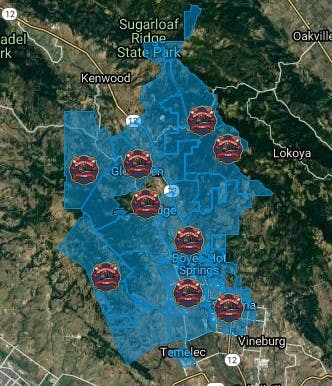ISO / Insurarance Rating Information
The SVFD is an all-risk full-time career staffed fire department that provides all-risk fire, rescue, and emergency medical services to the communities of Agua Caliente, Boyes Hot Springs, Mayacamas, Diamond-A, El Verano, Fetters Hot Springs, Glen Ellen, Temelec, Seven Flags and the incorporated City of Sonoma.
Recently the SVFD has recieved a number of calls from Insurance Companies requesting information. Below is a complete list of information that pertains to all residential properties within our fire district. If you need additional information not answered on this page please schedule an onsite property inspection (Inspection Fees will be applied) by clicking here -> Schedule an Inspection
ISO Ratings
Recently The SVFD has begun a reevaluation of its ISO rating. The current numbers have not been released. Once this information is released including the mergers of SVFD with Glen Ellen, Mayacamas, and the Kenwood Fire Protection District's (now one fire district) we will update the information here.
City of Sonoma - Class 1
Unincorporated areas of the Sonoma Valley - Class 2/10*
Glen Ellen - Class 2/10*
Kenwood - Class 04/4Y
Mayacamas - Class 8b/10*
* Rating is 10 when property location is greater than 5 miles from a fire station.
Fire Station Addresses:
Station 1 - 630 2nd St W, Sonoma, CA 95476 (ISO rating 1)
Station 2- 877 Center St, Sonoma, CA 95476 (ISO rating 2)
Station 3 - 1 Agua Caliente Rd W, Sonoma, CA 95476 (ISO rating 2)
Station 4 - 18798 Prospect Dr, Sonoma, CA 95476 (ISO rating 2)
Station 5 - 13445 Arnold Dr, Glen Ellen, CA 95442 (ISO rating 2)
Station 6 - 9045 Sonoma Highway, Kenwood, CA 95452
Station 8 - 3252 Trinity Rd, Glen Ellen, CA 95442
Station 9 - 4601 Cavedale Rd, Glen Ellen, CA 95442
Station 10 - 36 Wilson St, Eldridge, CA 95431 (ISO rating 2)
SVFD Fire Apparatus
Type 1 fire engines - 10 - average gallons of water 800 each - 1250-1500 gpm
Ladder Truck - 1 - 500 gallons water - 1500 gpm
Type 2 /3 fire engines - 7 - average gallons 750 gallons each
Type 6 fire engines - 3 - average gallons 300 each
Water Tenders - 4- average 2000 gallons each
Rescue / Rehab - 2
Ambulances - 6
Utility / Command Vehicles - 14
SVFD Fire Response Data
What comes to a property when there is a fire?
The below represents a typical response to a confirmed structure fire to a home located within the Sonoma Valley Fire District. This represents a first alarm "working" fire response and when needed additional resources will be ordered.

Fire Suppression Rating Schedule (FSRS) Overview
The Fire Suppression Rating Schedule (FSRS) is a manual containing the criteria ISO uses in reviewing the fire prevention and fire suppression capabilities of individual communities or fire protection areas. The schedule measures the major elements of a community’s fire protection system and develops a numerical grading called a Public Protection Classification (PPC®).
Our FSRS employs nationally accepted standards developed by such organizations as the National Fire Protection Association (NFPA), the American Water Works Association (AWWA), and the Association of Public-Safety Communications Officials (APCO) International. When those organizations update their standards, the ISO evaluation changes as well. The PPC program always provides a useful benchmark that helps fire departments and other public officials measure the effectiveness of their efforts — and plan improvements.
How the FSRS works
The FSRS lists a large number of items (facilities and practices) that a community should have to fight fires effectively. The schedule is performance based and assigns credit points for each item. Using the credit points and various formulas, ISO calculates a total score on a scale of 0 to 105.5.
To receive certain PPC ratings, a community must meet minimum criteria. After a community meets those criteria, the PPC rating depends on the community’s score on the point scale. For more information, see:
- Minimum Facilities and Practices to Get a PPC Rating
- Minimum Criteria for Class 9
- Minimum Criteria for Class 8B
- Minimum Criteria for Class 8 or Better
- Scores and PPC Ratings
The FSRS considers three main areas of a community’s fire suppression system: emergency communications, fire department (including operational considerations), and water supply. In addition, it includes a Community Risk Reduction section that recognizes community efforts to reduce losses through fire prevention, public fire safety education, and fire investigation.

